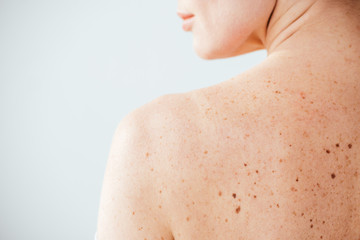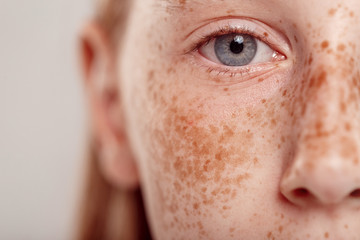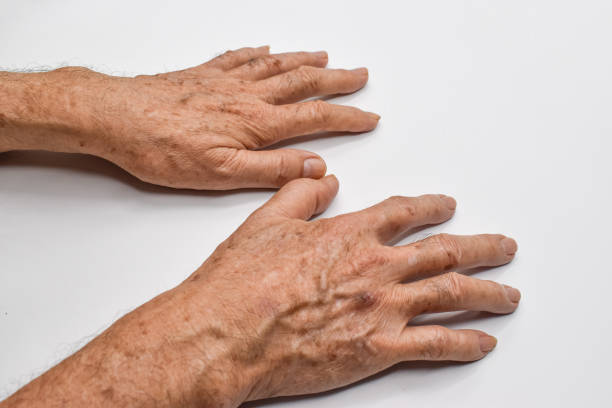Skin lesions like moles, freckles, and skin tags are common occurrences on the body, often causing curiosity and sometimes concern.
There are several types of skin lesions that are common and benign (noncancerous). These include:
- Moles
- Freckles
- Skin tags
- Benign lentigines (liver spots)
- Seborrheic keratoses
What Are Moles?

Moles are growths on the skin that are usually brown or black. They can appear anywhere on the body, either alone or in clusters. Most moles develop during early childhood and within the first 25 years of life. By adulthood, it’s typical to have between 10 and 40 moles.
Causes of Moles
Moles form when skin cells, called melanocytes, grow in clusters rather than spreading out. These cells produce the pigment that gives skin its color. Moles can darken due to sun exposure, during teenage years, or during pregnancy.
Changes in Moles Over Time
As you age, moles often change slowly. They may become raised, change color, or even grow hairs. Some moles might remain unchanged, while others might gradually disappear.
Types of Moles
- Congenital Nevi: Moles present at birth, occurring in about 1 in 100 people. These have a slightly higher risk of becoming melanoma.
- Dysplastic Nevi: Larger and irregularly shaped moles with uneven color. People with 10 or more dysplastic nevi have a significantly higher risk of melanoma.
Identifying Cancerous Moles
Most moles are harmless, but some can be a sign of skin cancer. Moles that look different from others or those that appear after age 25 should be examined by a dermatologist. Watch for changes in a mole’s color, height, size, or shape, and seek medical advice if a mole starts to bleed, ooze, itch, or become tender or painful.
Self-Examination Tips
To monitor your moles:
- Use a mirror or ask for help to check areas exposed to the sun, like your hands, arms, chest, neck, face, ears, legs, and back.
- Pay attention to any new moles or changes in existing ones.
The ABCDEs of Mole Examination
When examining moles, remember the ABCDEs:
- Asymmetry: One half of the mole does not match the other half.
- Border: The edges are ragged, blurred, or irregular.
- Color: The color is inconsistent, with shades of tan, brown, black, blue, white, or red.
- Diameter: The mole is larger than a pencil eraser.
- Evolution: The mole changes in size, shape, or color over time.
Melanoma, a serious form of skin cancer, often appears on the chest and back in men and on the lower legs in women. It’s the most common cancer in young women.
Treatment of Moles
If a dermatologist suspects a mole might be cancerous, they will perform a biopsy by shaving or cutting out the mole to examine it under a microscope. This simple procedure does not spread cancer. If the mole is cancerous, the dermatologist will remove it along with a margin of normal skin and close the wound with stitches.
What are Freckles?

Freckles are small, brown spots that typically appear on the face, neck, chest, and arms. They are extremely common, especially among people with lighter skin and those with red or light hair. Freckles are more noticeable in the summer and pose no health risk.
Causes of Freckles
Freckles are mainly caused by genetics and sun exposure.
Treatment of Freckles
Freckles are almost always harmless and don’t require treatment. However, it’s essential to protect your skin from the sun. Use a broad-spectrum sunscreen with at least SPF 30, as people prone to freckles (usually lighter-skinned individuals) have a higher risk of skin cancer.
For those who dislike the appearance of their freckles, options include:
- Covering them with makeup
- Laser treatment
- Liquid nitrogen treatment
- Chemical peels
What Are Skin Tags?

Skin tags, also known as acrochordons, are benign growths that affect about half of all adults. These small flaps of tissue hang off the skin by a tiny stalk. While the exact cause of skin tags is unknown, skin friction is believed to be a contributing factor.
Common Locations for Skin Tags
Skin tags commonly appear in areas where skin rubs against skin or clothing, including:
- Neck
- Chest
- Back
- Armpits
- Under the breasts
- Groin area
They are more frequently found in women, especially those who have gained weight, and in middle-aged and older adults.
Are Skin Tags Dangerous?
Skin tags are not harmful and usually do not cause pain. However, they can become irritated from friction with clothing, jewelry, or other skin surfaces.
How Are Skin Tags Treated?
If you want to remove a skin tag, a dermatologist can perform one of the following procedures:
- Cutting it off: Using a scalpel or scissors.
- Cryosurgery: Freezing the skin tag off.
- Electrosurgery: Burning it off with an electric current.
These treatments are straightforward and can help remove skin tags if they become bothersome or for cosmetic reasons.
What are Lentigines (Liver Spots)

Lentigines, commonly known as liver spots, are flat, brown patches that appear on the skin. These spots are darker than the surrounding skin and often show up in sun-exposed areas. They are more prevalent among White people, especially those with fair skin.
Causes of Lentigines
The primary cause of lentigines is sun exposure. They commonly appear on areas frequently exposed to the sun, like the face and hands. Genetics can also play a role, and in rare cases, conditions like Noonan syndrome with multiple lentigines can cause these spots along with other health issues. Medical procedures such as radiation therapy may also contribute to their development.
Treatment of Lentigines
Several treatments can help reduce the appearance of lentigines:
- Cryosurgery (freezing the spots off)
- Laser surgery
- Skin creams, such as retinoids and bleaching agents
Prevention of Lentigines
To prevent lentigines:
- Avoid the sun between 10 a.m. and 2 p.m.
- Use a broad-spectrum sunscreen with SPF 30 or higher.
- Wear protective clothing, including long-sleeved shirts, pants, and wide-brimmed hats.
- Avoid tanning beds.
What Are Seborrheic Keratoses?
Seborrheic keratoses are benign growths that appear brown or black. Commonly found on the chest, back, and head, these growths originate from cells known as keratinocytes. As they mature, seborrheic keratoses develop a warty texture. Importantly, they do not typically progress to skin cancer.
Causes of Seborrheic Keratoses
The exact cause of seborrheic keratoses remains unknown, but they are more frequently observed in older adults.
Treatment of Seborrheic Keratoses
Since seborrheic keratoses are harmless and non-contagious, treatment is usually unnecessary. However, if you wish to remove them for cosmetic reasons or if they become irritated by clothing, there are several removal options:
- Cutting them off: Surgical removal with a scalpel or scissors.
- Cryosurgery: Freezing the growths off.
- Electrosurgery: Using an electric current to burn them off.
Home Care Tips for moles, freckles, and skin tags
Avoiding excessive sun exposure and wearing sunscreen daily can help prevent the development of moles and freckles. For skin tags, keeping the affected areas clean and dry may prevent irritation and reduce their likelihood of formation.
When to See a Doctor
It’s essential to consult a dermatologist if you notice any changes in the size, shape, or color of moles, as well as if they become itchy, painful, or bleed. Similarly, persistent or rapidly growing skin tags should be evaluated by a medical professional.
Outlook/Prognosis
Most moles, freckles, and skin tags are harmless and do not require treatment unless causing discomfort or cosmetic concerns. However, regular skin checks and sun protection are crucial for early detection of any abnormalities and reducing the risk of skin cancer.
Sources
- American Academy of Dermatology Association. (n.d.). Moles: Signs and Symptoms.
- Skin Cancer Foundation. (2022). Moles, Freckles, and Skin Tags.
- Mayo Clinic. (2022). Skin Tags.
- FDA.
- Medline Plus / National Library of Medicine.
- National Organization for Rare Disorders.
- American Osteopathic College of Dermatology.
- AARP.